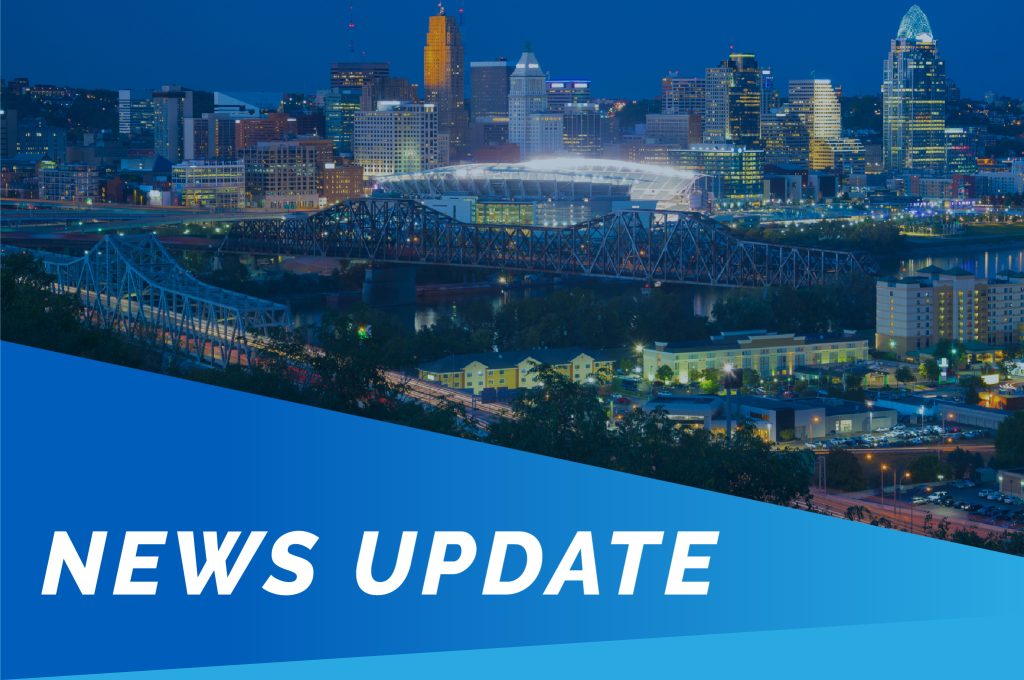
COLUMBUS — Ohio Governor Mike DeWine and Kentucky Governor Andy Beshear announce the awarding of federal funding grants worth $1.635 billion for the Brent Spence Bridge Corridor Project – giving the landmark bridge and corridor project the green light to move toward construction.
“Ohio and Kentucky have been discussing the Brent Spence Bridge Corridor Project for almost two decades, and now, we can finally move beyond the talk and get to work,” said Governor DeWine. “This project will not only ease the traffic nightmare that drivers have suffered through for years, but it will also help ensure that the movement of the supply chain doesn’t stall on this nationally significant corridor. My administration vowed to press the federal government to fund this project, and we’re glad that they have recognized its significance. I’m grateful to the teams in both states who have worked so hard to make this project a reality.”
With funding secured, groundbreaking on the project is anticipated for late 2023, with substantial completion slated for 2029.
“I’m thrilled the time has finally come for us to get the companion bridge built,” Gov. Beshear said. “Funding and constructing the Brent Spence Bridge Corridor Project is more than the fulfillment of my administration’s promise – it’s a dream-fulfilled for the thousands of travelers who pass through the bustling region every day waiting eagerly for traffic relief to come on this nationally significant corridor. It also shows what’s possible when we prioritize people over politics. Once complete, drivers will have a more enjoyable and efficient drive and we’ll have the infrastructure in place to support the booming economy in this part of the state. Hats off to the Kentucky Transportation Cabinet and Ohio Department of Transportation, and countless partners and advocates who played a role in today’s monumental achievement including the General Assembly for the last budget allocation. We greatly appreciate President Biden and Secretary Buttigieg for this historic investment.”
The Brent Spence Bridge was constructed in the 1960s to carry around 80,000 vehicles a day, but the daily I-75 and I-71 traffic load has reached 160,000 vehicles in recent years. Because I-75 is a key freight corridor stretching from Canada to Florida, the congestion impacts commerce and commuters who travel the corridor in the eastern United States.
Project plans call for the construction of a companion bridge to the west of the existing Brent Spence Bridge, as well as improvements to the current bridge and the roadway network that ties into each river crossing. As a result of robust engagement with local partners, there will be enhanced pedestrian access across I-75 in Cincinnati to reconnect downtown with western neighborhoods and the City of Cincinnati will regain nearly 10 acres of land to develop in the downtown area. In Kentucky, the project will include a new storm sewer system to reduce flooding and improve local roads, including enhanced pedestrian and bicycle facilities, in the area of the existing and new bridge.
The project team – consisting of representatives from the Ohio Department of Transportation (ODOT) and Kentucky Transportation Cabinet (KYTC) – applied jointly for funding and have outlined terms to move the project to construction.
The once-in-a-lifetime competitive funding was made available through the passage of the federal Bipartisan Infrastructure Law that invested billions of dollars to revitalize infrastructure and spur the economy.
In July, Governors DeWine and Beshear announced revised plans based on community engagement and technical analysis to shrink the project footprint while still delivering a transformative project that meets the needs of the region.
“Nothing great is achieved alone and I’m proud of all the people who’ve come to the table over the years to ensure that we’ll deliver a project with huge benefits and minimal impacts to the communities that live in and around the project area,” KYTC Secretary Jim Gray said.
“This project doesn’t just move vehicles, it moves people. We’re able to reconnect neighborhoods to downtown Cincinnati, improve safety, and reduce congestion on this route, all while only adding a single lane to the interstate with this project,” said ODOT Director Jack Marchbanks.
With funding secured, groundbreaking on the project is anticipated in late 2023 with larger construction activities in 2024. Substantial completion on the project is slated for 2029. The immediate next step will be the selection process to determine the Progressive Design Build contractor team to complete the project. That effort will begin in January when the Request for Proposals (RFP) is released to the contractor community.
The Federal Highway Administration recently required the project team to complete an analysis to better identify project cost estimates. Through this process, the project team determined the project is likely to cost about $3.6 billion. The increase from previous estimates was not unexpected due to the recent impact of inflation in construction prices. As a result, the project team is updating the project’s financial plan to account for the change.
About the Brent Spence Bridge Corridor Project
Brent Spence Bridge Fact Sheet
Fueled by bipartisan cooperation and community engagement, the Brent Spence Bridge Corridor Project will invest in local communities and help grow America’s economy. Spanning eight miles between the Western Hills Viaduct in Ohio and Dixie Highway in Kentucky, the project will address the second-worst truck bottleneck in the nation by improving safety and travel on the interstate connection that carries more than $700 billion worth of freight every year.
In addition, the project will improve access to the central business districts of Cincinnati, Ohio, and Covington, Kentucky, and will also support local businesses and underserved communities in historic neighborhoods on both sides of the river. Ohio and Kentucky are working together to deliver this transformative project that will improve the quality of life for the millions of Americans who use the federal highway system to travel between the two states and beyond.
